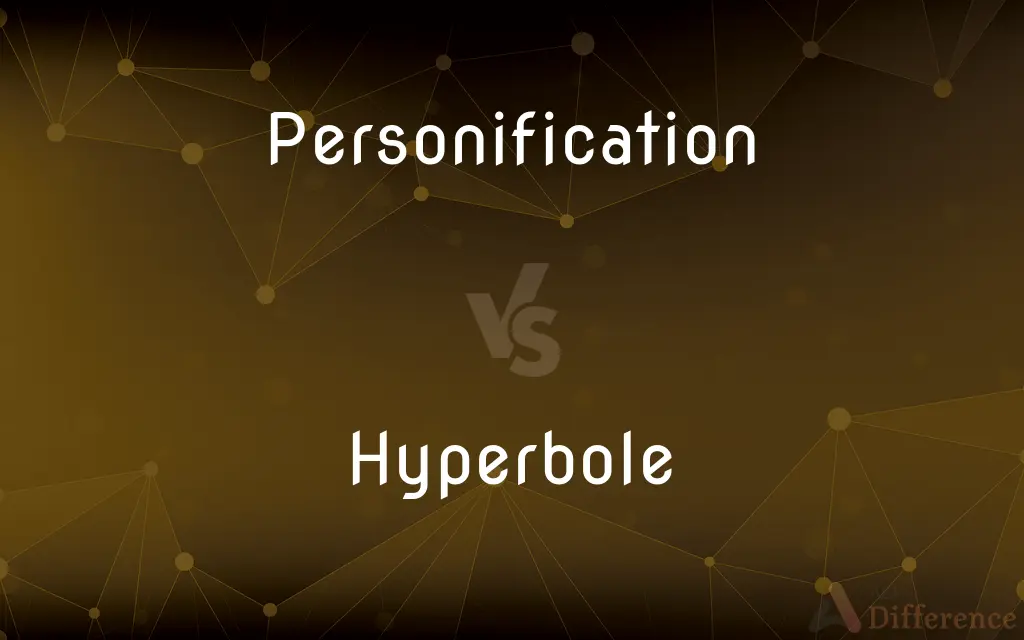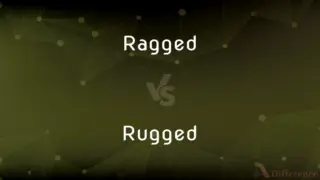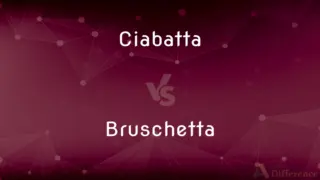Personification vs. Hyperbole — What's the Difference?
By Urooj Arif & Maham Liaqat — Updated on March 11, 2024
Personification is a literary device where human traits are attributed to non-human entities, while hyperbole involves exaggerated statements or claims not meant to be taken literally.

Difference Between Personification and Hyperbole
Table of Contents
ADVERTISEMENT
Key Differences
Personification brings non-human elements to life by assigning them human qualities, emotions, or actions, making descriptions more vivid and relatable. For example, when a writer says "the wind whispered secrets," the wind is given the human ability to whisper, enhancing the narrative's atmospheric quality. Hyperbole, on the other hand, amplifies reality to create emphasis or effect, such as saying "I'm so hungry I could eat a horse," which exaggerates the speaker's hunger without the intent of being taken literally.
The purpose of personification is often to evoke empathy or a deeper understanding of the described entity by relating it to human experience, making abstract or inanimate concepts more accessible. Hyperbole aims to grab attention, highlight a point, or convey strong emotions by stretching the truth, making the expression more dramatic or humorous.
In terms of usage, personification can be found across various genres to enrich imagery and connect readers with the subject on a human level. Hyperbole is widely used in everyday language, literature, advertising, and speeches to intensify descriptions and engage the audience with bold and memorable statements.
While personification requires the reader to imagine non-human entities behaving as humans, hyperbole asks the reader to recognize the exaggeration and find the underlying truth or intensity of the sentiment being expressed. Both devices serve to enhance the expressiveness of language but do so through different mechanisms.
Despite their differences, personification and hyperbole can coexist within a single sentence or passage, contributing to a rich, layered effect. Writers may use both to add depth, humor, or emphasis, showcasing the versatility and creativity of language.
ADVERTISEMENT
Comparison Chart
Definition
Attribution of human qualities to non-human entities.
Exaggerated statements not meant to be literal.
Purpose
To evoke empathy and make descriptions relatable.
To emphasize or create a dramatic effect.
Usage
In imagery, to bring life to inanimate objects or concepts.
In everyday language and literature for emphasis or humor.
Effect
Makes abstract or non-human elements more accessible.
Highlights intensity or evokes strong emotions.
Reader's Role
To relate non-human elements to human experience.
To recognize the exaggeration and find the underlying truth.
Compare with Definitions
Personification
Giving human characteristics to the non-human.
The moon smiled down at us.
Hyperbole
Common in humorous or emphatic expressions.
He ran faster than the wind.
Personification
Making inanimate objects or abstract ideas relatable.
Time waits for no one.
Hyperbole
Exaggerated statements for effect.
I've told you a million times.
Personification
Applies human actions to nature or objects.
The leaves waved in the wind.
Hyperbole
Used to convey strong feelings or impressions.
I could sleep for a year.
Personification
Enriches narrative by adding depth to descriptions.
The old car coughed and sputtered to life.
Hyperbole
Amplifies reality to make a point.
Her smile was brighter than the sun.
Personification
Used to enhance imagery and emotional connection.
The city's buildings danced in the moonlight.
Hyperbole
Not intended to be taken literally.
This bag weighs a ton.
Personification
The attribution of a personal nature or human characteristics to something non-human, or the representation of an abstract quality in human form
The book provides a sustained account of how literary personification works
Hyperbole
Hyperbole (, listen) (adjective form hyperbolic, listen) is the use of exaggeration as a rhetorical device or figure of speech. In rhetoric, it is also sometimes known as auxesis (literally 'growth').
Personification
A figure intended to represent an abstract quality
The knight is accompanied by two feminine personifications of vice
Hyperbole
Exaggerated statements or claims not meant to be taken literally
He vowed revenge with oaths and hyperboles
You can't accuse us of hyperbole
Personification
The act of personifying.
Hyperbole
A figure of speech in which exaggeration is used for emphasis or effect, as in I could sleep for a year or This book weighs a ton.
Personification
A person or thing typifying a certain quality or idea; an embodiment or exemplification
"He's invisible, a walking personification of the Negative" (Ralph Ellison).
Hyperbole
Deliberate or unintentional overstatement, particularly extreme overstatement.
Personification
A figure of speech in which inanimate objects or abstractions are endowed with human qualities or are represented as possessing human form, as in Hunger sat shivering on the road or Flowers danced about the lawn. Also called prosopopeia.
Hyperbole
(countable) An instance or example of such overstatement.
Personification
Artistic representation of an abstract quality or idea as a person.
Hyperbole
A hyperbola.
Personification
A person, thing or name typifying a certain quality or idea; an embodiment or exemplification.
Adolf Hitler was the personification of anti-Semitism.
Hyperbole
A figure of speech in which the expression is an evident exaggeration of the meaning intended to be conveyed, or by which things are represented as much greater or less, better or worse, than they really are; a statement exaggerated fancifully, through excitement, or for effect.
Our common forms of compliment are almost all of them extravagant hyperboles.
Somebody has said of the boldest figure in rhetoric, the hyperbole, that it lies without deceiving.
Personification
A literary device in which an inanimate object or an idea is given human qualities.
The writer used personification to convey her ideas.
Hyperbole
Extravagant exaggeration
Personification
The act of personifying; impersonation; embodiment.
Personification
A figure of speech in which an inanimate object or abstract idea is represented as animated, or endowed with personality; prosopop ia; as, the floods clap their hands.
Personification
A person who represents an abstract quality;
She is the personification of optimism
Personification
Representing an abstract quality or idea as a person or creature
Personification
The act of attributing human characteristics to abstract ideas etc.
Common Curiosities
Can personification and hyperbole be used together?
Yes, writers often combine them for a more vivid or impactful expression.
Is hyperbole effective in persuasive writing?
Hyperbole can be persuasive by intensifying the importance or urgency of a message.
Is personification only used in literature?
While common in literature, personification is also used in advertising, film, and everyday speech.
Can personification apply to animals?
Yes, animals can be personified by attributing human emotions or actions to them.
Is personification meant to be realistic?
Personification is not about realism but about creating relatable or vivid imagery.
Do all cultures use personification in the same way?
Personification is a global literary device, but its use and interpretation can vary culturally.
Are hyperboles always obvious?
Hyperboles are usually clear through context, but can sometimes be mistaken for literal statements.
Can hyperbole be a form of irony?
Hyperbole can contribute to irony, especially when the exaggeration contrasts sharply with reality.
Are there limits to using hyperbole?
While hyperbole is flexible, its effectiveness depends on the context and audience's willingness to accept exaggeration.
How do readers identify personification?
Readers recognize personification by noting human traits or actions attributed to non-human elements.
Share Your Discovery

Previous Comparison
Ragged vs. Rugged
Next Comparison
Ciabatta vs. BruschettaAuthor Spotlight
Written by
Urooj ArifUrooj is a skilled content writer at Ask Difference, known for her exceptional ability to simplify complex topics into engaging and informative content. With a passion for research and a flair for clear, concise writing, she consistently delivers articles that resonate with our diverse audience.
Co-written by
Maham Liaqat















































